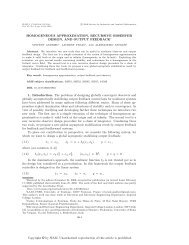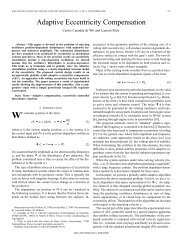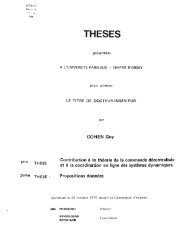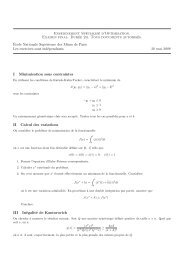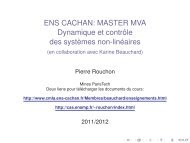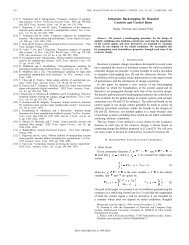1186 IEEE TRANSACTIONS ON AUTOMATIC CONTROL, VOL. AC-30. NO. 12, DECEMBER 1985with a normalized estimator has been presented. Systems witharbitrary relative degree may be considered (in contrast to thecontinuous-time robustness studies [lo], [21]) however we requirethe latter to be known. The stability conditions reduce to theexistence <strong>of</strong> a linear regulator (<strong>of</strong> the chosen structure) such that:1) +e closed-loop tracking transfer function "approaches" thedesired closed-loop behavior; 2) "good" disturbance rejectionproperties are attainable. Increasing the speed <strong>of</strong> adaptationrenders these requirements more stringent.Although the two previous conditions preserve the essence <strong>of</strong>the usual performance (in the sense <strong>of</strong> pole-placement) anddisturbance rejection design objectives, they unfortunately do not<strong>of</strong>fer any engineering design guidelines. The primary culprit hereis the notion <strong>of</strong> transfer function vicinity (as stated in 1) above)which requires that the phase:shift between the attainable and thedesired transfer functions should not exceed go", at all frequencies.This has been referred to in the literature as the positive realcondition (<strong>of</strong> Hz).One fundamental difference arises at this point betweencontinuous and discrete-lime robustness results. In the latter theassumption <strong>of</strong> known delay permits us to obtain a parametrizationwhere H2 has the relative degree zero. In terms <strong>of</strong> the Nyquistlocus this implies that for all stably invertible processes the overallphase shift contribution is zero, i.e., the locus starts and ends inthe same side <strong>of</strong> the complex plane. Therefore, since phasemodification (usually phase lead) is only required over a limitedfrequency range. it will always be possible by proper filtering tosatisfy the positivity condition. TWO important questions remainhowever to be solved. How should we incorporate the availableprior knowledge to convert the conicity conditions into tests forrobustness? The second question is more disturbing. How shouldwe deal with nonstably invertible process, very likely to appear ina discrete-time context?APPENDIXFrom (3.4c), (3.8), (3.9). d = 1, we have the followingproperty.Lemma: If there exist E > 0 and No such thatwithNTherefore XI F;l - I is positive definite for any finite t.ii) F,' has a symmetric positive definite square root Fl'1/2 andwe havewe haveThis proves that:y = Fr' '/?xx TF; 'xmax-=A max F; IF;x xTFr'-'xiii) If A is a symmetric positive definite matrix, thenxTAx~(1 +X max A)xTA((I+A)-Ix, v x.This is proved by noticing that we can choose a symmetricpositive definite square root A which commutes with (I +A) -I. Then withThe inequality becomes simply=A I/2 X.yTy
ORTEGA el al.: DISCRETE-TIME DIRECT ADAPTIVE CONTROLLERSThen with fact iii), it follows that (in the sense <strong>of</strong> quadratic form)This impliesThe conclusion follows from the assumption and the prop6rties <strong>of</strong>Gr. 0ACKNOWLEDGMENTThe authors are grateful to C. E. Rohrs and the anonymousreviewers for many valuable suggestions.r11r21I31r41r61REFERENCESJ. C. Doyle and G. Stein, “Multivariable feedback design: Conceptsfor a modern/classical synthesis,” ZEEE Trans. Automat. Contr.,vol. AC-26, pp. 4-17, Feb. 1981.M. C. Safonov, Stability <strong>Robustness</strong> <strong>of</strong> Multivariable FeedbackSystems. Cambridge, MA: M.I.T. Press, 1980.R. L. Kosut, “Analysis <strong>of</strong> performance robustness for uncertainmultivariable systems,” in Proc. 21st Conf. Decision Contr.,Orlando, FL, Dec. 8-10, 1982.C. E. Rohrs, “<strong>Adaptive</strong> control in the presence <strong>of</strong> unmodeleddynamics,” Mass. Inst. Technol., Cambridge, MA, Rep. LIDS-TH-1254, Nov. 1982.R. Ortega and I. Landau, “On the design <strong>of</strong> robustly performingadaptive controllers for partially modeled system,’’ in Proc. 22ndZEEE Conf. Decision Contr., San Antonio, TX, Dec. 14-16, 1983.I. D. Landau and H. M. Silveira, “A stability theorem withapplications to adaptive control,” ZEEE Trans. Automat. Contr.,VOI. AC-24, pp. 305-311, 1979.P. J. Gawthrop, “On the stability and convergence <strong>of</strong> a self-tuningcontroller,” Int. J. Contr., vol. 31, pp. 973-998, 1980.P. J. Gawthrop and K. W. Lim, “<strong>Robustness</strong> <strong>of</strong> self-tuning controllers,”IEEE Proc., vol. 129, pp. 21-29, Jan. 1982.C. A. Desoer and M. Vidyasagar, Feedback Systems: Input-OutputProperties New York: Academic, 1975.R. L. Kosut and B. Friedlander, “Performance robustness properties <strong>of</strong>adaptive control systems,” in Proc. 21sf Conf. Decision Contr.,Orlando, FL, Dec. 8-10, 1982; also in “Robust adaptive controlconditions for global stability,” in IEEE Trans. Automat. Contr.,vol. AC-30, no. 7, pp. 610-624, July 1985.I. D. Landau, “MRAC and stochastic STR-a unified approach,”Trans. ASME J. Dynam. Syst. Meas. Contr., Dec. 1981.R. Ortega, “Assessment <strong>of</strong> stability robustness for adaptive controllers,”IEEE Trans. Automat. Contr., vol. AC-28, p. 1106, 1983.K. S. Narendra, “Stable adaptive controller design: pro<strong>of</strong> <strong>of</strong> stability,”ZEEE Trans. Automat. Contr., vol. AC-25, June 1980.P. J. Gawthrop, “Some properties <strong>of</strong> discrete adaptive controllers,” inSelf-Tuning & <strong>Adaptive</strong> Control, Harris and Billings. Eds. NewYork: Peregrinus, 1981.R. Ortega and I. D. Landau, “On the MPM tolerance <strong>of</strong> various PAA:A sectoricity approach,” ZFAC WorkshoD AdaDt. - Syst., . SanFrancisco, CA, jine 20-22, 1983.S. Shah, “Internal model adaptive control,” Stanford Univ., Stanford,CA, Rep. 63-81-2, Aug. 1981.G. Zames, “On the I/O stability <strong>of</strong> time varying nonlinear feed-backsystems Part I & 11,” ZEEE Trans. Automat. Contr., vol. AC-11,1366.[18] B. Peterson and K. S. Narendra, “Bounded Error adaptive control,”ZEEE Trans. Automat. Contr., vol. AC-27, Dec. 1982.[I91 G. Kreisselmeier and K. S. Narendra, “Stable MRAC in the presence<strong>of</strong> bounded disturbances,” IEEE Trans. Automat. Confr., vol. AC-27, Dec. 1982.[20] M. J. Balas and C. R. Johnson, “<strong>Adaptive</strong> identification and controlusing reduced-order models,’’ Yale Adapt. Confr. Conf., 1981.[21] P. Ioannou and P. W. Kokotovic, <strong>Adaptive</strong> Systems with ReducedModels. New York: Springer-Verlag, 1983.[22] R. Kosut and C. Johnson, “An input-output view <strong>of</strong> robustness inadaptive control,” Automatica, (Special Issue on <strong>Adaptive</strong> Control),1984.[3 111187K. W. Lim, “<strong>Robustness</strong> <strong>of</strong> self-tuning controllers,” Ph.D. dissertation,Hertford Coll., Oxford, England, 1982.L. Praly, “<strong>Robustness</strong> <strong>of</strong> model reference adaptive control,” in Proc.3rd Yale Workshop, New Haven, CT, June 15-17, 1983.B. Egardt, Stability <strong>of</strong> <strong>Adaptive</strong> <strong>Controllers</strong>. New York: Springer-Verlag, 1979.G. Goodwin, P. Ramadge and P. Caines, “<strong>Discrete</strong> time multivariableadaptive control,” ZEEE Trans. Automat. Contr., vol. AC-25, June1980.T. Hagglund, New Estimation Techniques for <strong>Adaptive</strong> Control.Coden: LUTFD2/(TFRT-1025)/1-20/1983. Lund University.L. Praly, “Commande adaptive indirecte multivariable,” Coll; Nat.du CNRS., Belle IIe, Sept. 1982.-, “Robust MRAC: Stability analysis,” in Proc. 23rd ZEEEConf. Decision Contr., Dec. 1984.-, “<strong>Robustness</strong> <strong>of</strong> mdlrect adaptive control based on pole placementdesign,” in Proc. ZFAC Workshop on <strong>Adaptive</strong> Syst. inContr. and Signal Processing., June 1983.R. Ortega, “<strong>Robustness</strong> enhancement <strong>of</strong> adaptive controllers byincorporation <strong>of</strong> process apriori knowledge,” Syst. Contr. Lett., vol.4, pp. 135-141, May 1984; see also “Correction,” ibid. vol. 4, Oct.1984.Romeo Ortega was born in Mexico, on March 12,1954. He received the B.S. degree in mechanicaland .electrical engineering from the NationalUniversity <strong>of</strong> Mexico in 1975, the M.on E. degree(with honors) in control theory from the LeningradPolytechnical Institute, USSR, and the “Doctoratd’Etat-es-Sciences” degree from the PolytechnicalInstitute <strong>of</strong> Grenoble, Grenoble, France.He has held teaching and research positions at theNational University and Polytechnical Institute <strong>of</strong>Mexico. He is currently a Pr<strong>of</strong>essor in the Faculty<strong>of</strong> Engineering, Nation al University <strong>of</strong> Mexico. His main research interestsare in the development <strong>of</strong> analysis and design techniques for reliable controlsystems.Laurent Praly was born in 1954. He graduatedfrom Ecole Nationale Superieure des Mines deParis, Paris, France, in 1976.After working as Engineer in a private laboratoryfor three years, in 1980 he joined the <strong>Centre</strong>d’Automatique et Informatique, Ecole NationaleSuperieure des Mines de Paris, Fontainebleau,France. From July 1984 to June 1985, he spent asabbatical year as Visiting Assistant Pr<strong>of</strong>essor in theDepartment <strong>of</strong> Electrical and ComputerEngineering, University <strong>of</strong> Illinois,Urbana-Champaign. H is main interest is in automatic control withcontribution to adaptive systems.Ioan D. Landau received the Docteur-es-SciencesPhysiques degree from the University <strong>of</strong> Grenoble,Grenoble, France.He was an Associate Pr<strong>of</strong>essor at the InstitutNational Poytechnique de Grenoble from 1973 to1976 and a Senior Post-Doctoral ResearchAssociate at NASA-Ames Research Center from1971 to 1972. At present he is Research <strong>Direct</strong>or atthe <strong>Centre</strong> National de la Recherche Scientifique(C.N.R.S.). He is also <strong>Direct</strong>or <strong>of</strong> a nationalcoordinated research group at the Laboratoirede’Automatique, Institut National Polytechnique de Grenoble. He is theauthor <strong>of</strong> the book. <strong>Adaptive</strong> Control-The Model Reference Approach(New York: Marcel Dekker, 1979) and coauthor (with M. Tomizuka) <strong>of</strong> thebook <strong>Adaptive</strong> Control-Theory and Practice in Japanese (Ohm, 1981).Dr. Landau is the Chairman <strong>of</strong> the I.F.A.C. Working Group on <strong>Adaptive</strong>Systems in Control and Signal Processing. He received the Great Gold Medalat the Invention Exhibition, Vienna in 1968, the C.N.R.S. Silver Medal in1982 and the “Best Review Paper Award (1981-1984) for his paper “Modelreference adaptive controllers and stochastic self-tuning regulators-A unifiedapproach” published in the ASME Journal <strong>of</strong> Dynamical SystemsMeasurement and Control.Authorized licensed use limited to: ECOLE DES MINES PARIS. Downloaded on November 28, 2009 at 12:57 from IEEE Xplore. Restrictions apply.



